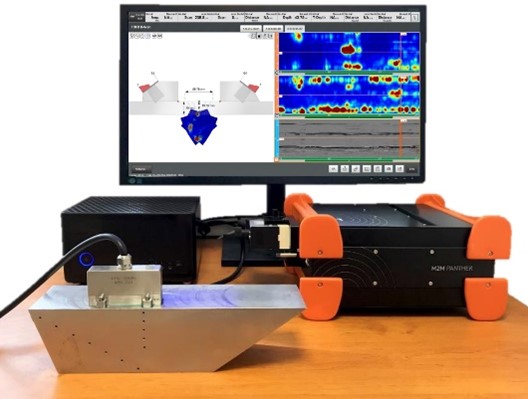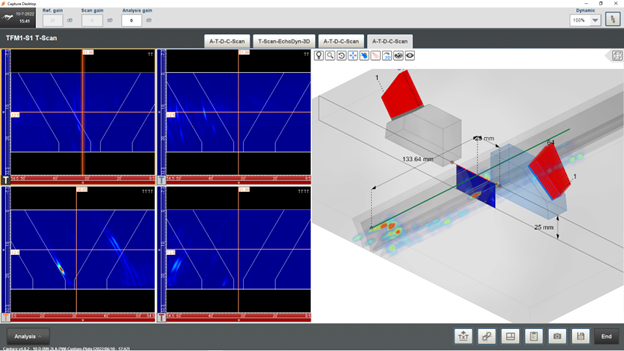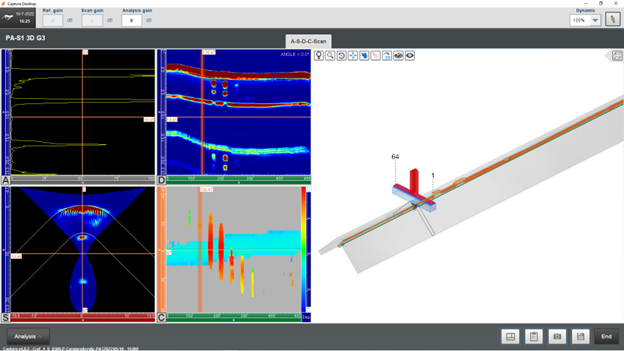Capture, the streamlined software embedded in Gekko and Mantis portable flaw detectors, was developed to provide operators with standard ultrasonic techniques such as conventional UT, PAUT and TOFD, and new techniques that were not available on portable PAUT systems at the time. The first software to propose TFM in real-time on a portable PAUT unit and Plane Wave Imaging (PWI). A code-compliant technique for TFM offering scanning speed of over 100 millimetres per second (1 inch per second), Capture with PWI had no competition. Multigroup and multiprobe were made available for TFM allowing inspectors to perform weld inspection from both sides of the weld at the same time while combining up to four different modes with up to 250 kpixels and 500 pixels each for the Mantis and Gekko, respectively. Full matrix capture (FMC) and PWI elementary data recordings are available for further post-processing analysis.
Capture is used from configuration definition, to acquisition, and finally for analysis. Despite being software developed for portable equipment, it can deal with complex configurations like fillet weld, nozzles, and real 2D CAD components. It can operate linear, matrix, dual linear, and dual matrix array probes. Operators can define complex scan plans for all ultrasonic techniques and display in real-time the following indicators:
- Angles between bevels and incident angles,
- incident angles,
- near-field information,
- beam spread for TOFD and UT,
- offsets, PCS, thickness, element number.
This allows operators to ensure full coverage of the part even when dealing with complex components and complex PAUT probes.
Providing superimpositions of complex component overlays to PAUT and TFM data allows operators to better position their probes. This also provides a better understanding of the origin of the various echoes, distinguishing more easily between geometry echoes and indications thus improving probability of detection (POD) and minimizing false calls.
From the very beginning, Capture software proposed innovative calibration wizards that require a mere three clicks to complete. Element check, wedge delay calibration even for circumferential outside diameter (COD) wedges, and time corrected gain (TCG) are quick and easy to perform.
On top of the traditional analytical tools available on commercially available PAUT systems, Capture also offers many automated analysis tools that improve productivity and repeatability. It is possible to perform automatic sizing of a defect based on a decibel drop method providing all the information associated with that indication (position, size, etc.) and sends them to a table of indications. The method is also available for corrosion mapping automatically extracting from a 2D map all the areas that suffered corrosion corresponding to criteria defined by the operator. An assisted analysis module for PAUT is also available providing automatic detection, filtering, and classifying indications based on standards before acceptance by the operator.
Capture is compatible with the Mantis 16:64 PAUT system and the Gekko available in 32:128PR, 64:64PR or 64:128PR PAUT configurations.
.jpg?width=780&name=My%20project-1%20(10).jpg)
This blog illustrates the commitment that Eddyfi Technologies has made to provide state-of-the-art features while listening to its customers. Since the beginning of Capture back in 2015, 17 major software versions have been released delivering on the promise to offer several major software updates each year.
Panther™ PAUT/TFM imaging machine
Panther is a phased array instrument designed for both desktop and industrial applications, offering unparalleled performance in a compact unit. It combines the speed required for industrial integrated PAUT solutions, with the most complete set of TFM imaging techniques, making it the ultimate tool for R&D and procedure qualification.
The recent rise in the graphics processing unit (GPU) computing power in a compact, industrial, and affordable format, provides a very flexible solution for both laboratories and industrial applications. It bridges advanced phased array methods such as TFM with the high-speed ultrasonic inspection requirements of the industry. It is designed with tremendous processing power provided by the GPU and a high data throughput between the instrumentation and the monitoring computer of up to 320 megabytes per second with a USB 3.0 connection. For the most demanding applications, it is also equipped with an optical fiber connection that increases the data throughput up to 810 megabytes per second.
It is possible to control the Panther in several different ways.
Its natural operating system, Acquire, embeds a version of CIVA that allows the definition of the most complex configurations. It permits the inspection of components defined parametrically or by importing 2D or full 3D CAD files. Complex materials can be dealt with, isotropic and anisotropic, homogeneous, or heterogeneous. Acquire can deal with various PAUT probes designs: linear, matrix, annual, annular sectorial, random distribution single or dual configurations, in pulse-echo or pitch-catch modes. Any delay law can be calculated including fast modes, and TFM can be done from an FMC, a PWI, or any acquisition schemes.
The other option to control the Panther is through its Software Development Kit (SDK). The SDK is a communication layer platform between the customer’s software and Acquire. The services offered by this platform are particularly useful to integrate into complete turnkey NDT solutions with, for instance, motion controllers, a database to store the acquisitions and/or a simplified remote interface for the operator. The SDK can also be used to automate tedious tasks and perform advanced scripted operations thus enhancing the possibilities offered by Acquire.
Available with multiple architectures from 32:128 all the way to 128:128 with or without TFM, it provides customers with a lot of flexibility. It is also possible to combine up to 16 units for the most demanding applications as seen here showing an example of 8 Panther units for the inspection of line pipe at speeds of one meter per second.
Panther and Capture: The Perfect Pair
Capture 4.0 extends the range of capabilities within the Eddyfi ecosystem. It is now possible to drive the Panther with Capture to benefit from both an easy-to-use interface with the processing power of the computer’s GPU.

Having Capture on a PC while driving the Panther allows customers to directly use any software (Excel, CIVA, Cmap, etc.) they are comfortable with to analyze their data directly without having to transfer data from the unit to the PC. They can also benefit from having a larger screen(s) and the processing power of their CPU to make Capture more fluid.
It is now possible to use probes with up to 128 elements for both PAUT and TFM applications allowing operators to use larger apertures for both linear and matrix arrays.
The biggest advantage is the added processing power of the GPU for the TFM technique. Capture with the Panther allows four groups with up to 1 million pixels each. A powerful GPU (Nvidia RTX 3000 series recommended) is able to handle big TFM zones that require such large amounts of pixels or smaller
The following image shows a TFM configuration using four groups (TT and TTTT) with two probes. We used a total of 90 kpixels per group. While the Gekko can achieve a reasonable scanning speed of 60 millimeters per second, the Panther with a USB 3.0 connection is capable of achieving a scanning speed of 160 millimeters per second with a laptop equipped with an RTX 3070 GPU. High scanning speeds are achievable with an optical fibre connection and a desktop GPU.

The following images show PAUT inspections performed on a nozzle and acrylic corner using the 2D CAD feature of Capture.


Of course, operators can use all the advanced analysis features mentioned before.
By combining this powerful software with the advanced PAUT instrument, Eddyfi Technologies closes the loop of software possibilities capable of driving the most powerful PAUT/TFM unit on the market. Controlling the unit using an easy-to-use interface like Capture, a more complex and complete software with Acquire, or for customers who want to develop their own interface, they can use the SDK.
For more information on the capabilities of the Capture™ software and our advanced PAUT and TFM offering, contact our experts today! And if you’re ready to build your own quote, check out the eStore with real-time pricing now.






